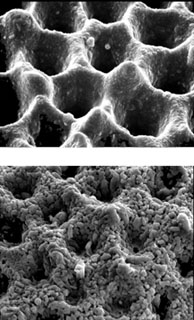 Now, a new
analysis of foraminifera shells in Tanzania may reconcile this so-called “cool
tropics paradox.” In the Oct. 4 Nature, Paul Pearson at the University
of Bristol and colleagues present findings to show that the cool tropics paradox
is not really a paradox at all, but rather a case of faulty fossil data. Past
research has been hampered by the difficulty in obtaining unaltered calcareous
shells of foraminifera, or forams, to study. Pearson and colleagues have found
well-preserved foraminifera, and argue that past sea surface temperatures in
the tropics were in fact much warmer than today’s.
Now, a new
analysis of foraminifera shells in Tanzania may reconcile this so-called “cool
tropics paradox.” In the Oct. 4 Nature, Paul Pearson at the University
of Bristol and colleagues present findings to show that the cool tropics paradox
is not really a paradox at all, but rather a case of faulty fossil data. Past
research has been hampered by the difficulty in obtaining unaltered calcareous
shells of foraminifera, or forams, to study. Pearson and colleagues have found
well-preserved foraminifera, and argue that past sea surface temperatures in
the tropics were in fact much warmer than today’s. Abundant in both modern and ancient oceans, foraminifera (forams) are protozoa whose shells accumulate on the seafloor. Paleoclimatologists use the oxygen isotopic compositions of foram shells to reconstruct past climate. Shells precipitated in warm water contain more of oxygen’s lighter isotope 160 than those formed in colder water. Pearson and his colleagues believe earlier paleotemperature results were suspect because plankton shells often recrystallize: on the cold seafloor, additional material accumulates on the shells and reduces the amount of oxygen-16.
[Well preserved (top) foram wall from Tanzania compared to ordinary preservation (bottom) from ODP Site 1052 in the western Atlantic. Courtesy of Paul Pearson.]
The Tanzanian shells that Pearson’s team studied, however, are different. The research team learned of rare, well-preserved forams in the Mandawa basin of southern Tanzania that exploration geologists routinely sampled in the 1950s. In collaboration with Tanzanian scientists, they returned to the basin to collect hundreds of new samples from two warm intervals of Earth’s history — one from the Eocene, 50 million years ago, and the other from the Late Cretaceous, about 70 million years ago. Pearson says they are well preserved because “they’re encased in fine-grained clay, which is very impermeable, so fluids don’t pass through the rock continuously over time causing a very continual degradation or destruction. Once they’re encased there, they remain more or less as they were.”
Also, Pearson says, the Mandawa basin area has gradually uplifted since the time the sediments deposited on the seafloor for reasons that are not entirely clear, possibly related to the rift valley volcanism to the west. The shells were never completely buried and consequently have not experienced the usual extreme temperature or pressure changes. “We almost couldn’t believe these were ancient rocks, and not modern mud,” he says.
Pearson and others’ found significantly higher concentrations of oxygen-16 in the Tanzanian shells than shells of similar age from past deep-sea core analyses. The resulting temperature estimates of tropical seas were 28 to 32 degrees Celsius, warmer temperatures more consistent with those predicted by climate models.
Pearson says he thinks their research has provided a solution to a problem that was becoming increasingly difficult for scientists to explain. They knew either the data were wrong or there was something else going on to create the clash between the models and the data. “We wouldn’t have thought so hard about the geochemistry if it hadn’t been for climate modeling,” Pearson says.
According to Howie Spero at the University of California-Davis, however, Jim Zachos, a paleooceanographer at the University of California-Santa Cruz (UCSC), is working on a rebuttal to the Pearson paper. Zachos was unavailable for comment. Others in the paleoclimatology community have welcomed the new data. “I believe Pearson et al.’s work is a step in the direction of reconciling model results and proxy interpretations. More importantly, this work is a step forward in more completely understanding the causes and dynamics of warm climates,” says Lisa Sloan, also at UCSC.
Pearson says that as the Ocean Drilling Program progresses, he hopes their work will aid drillers in locating mud layers from the Cretaceous and Eocene that preserve foram shells — providing new insight into our climate past and our climate future.

